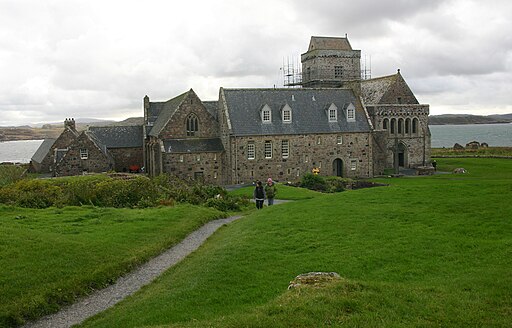Feast Day: June 9

One of the most peaceful places I’ve traveled is the isle of Iona on the western coast of the Scottish Highlands. You can find a holy silence on it amidst the cries of seabirds and the beating of turquoise water on dark rocks. Only a handful of people live there, along with sheep, puffins, seals, and small knots of tourists arriving on the local ferry. The kinds of tourist who come here walk in surprising quiet. They come as pilgrims either to bathe in salt-sprayed nature or to touch the ground where St. Columba first brought Christianity to northern Scotland.
The poetic ruins on the island also quietly teach the fragility of human peace. The experimental, ecumenical religious community on the island is a replacement for the great medieval abbey destroyed by zealous Scottish Protestants during the Reformation. That abbey was a refoundation of Columba’s original abbey, which had been destroyed by Vikings and left fallow for three hundred years. Iona has seen its share of violence, though its founder would not have been surprised. He understood both peace and human strife.

Columba and the Monsters
Columba came to Iona in the 560s from his native Ireland. He came as a penance. For a good Irishman, what could be a greater sacrifice than leaving his mother country and his clan to dwell as neighbors of pagan petty kings caught up in constant warfare? Different stories have been told about why he undertook this penance. When his powerful Uí Néill clan fought another clan, Columba (already a monk) seems to have abandoned his religious calling to either support the bloodshed or to give up fugitives who had sought sanctuary in the church. Going abroad may have helped secure peace at home. It also separated Columba from the temptation to rely on the protection of his clan. Instead, he had to rely on God. So he brought Christianity to Iona and the Highlands.
Columba’s most famous confrontation with danger happened on the inlet to Loch Ness. As Columba traveled to Inverness, he came upon a knot of people bending over a savaged corpse. They gravely told him that a monster had swum up from the lake and attacked. Columba decided that he would still cross the inlet despite their warnings. Sure enough, the monster attacked. It swam forward with teeth bared only to be met by Columba calmly facing it and making the sign of the cross. The Loch Ness monster turned and swam peacefully away.
That at least is the story written down a century later by Iona’s ninth abbot, Adomnán. You can decide to believe in Scotland’s beloved Nessie or not, but take comfort in the fact that Columba didn’t harm her. He had a quiet compassion even when ferociously condemning wrongdoing. He cursed a druid who had taken an innocent woman as a slave, but prayed for the druid’s healing when he released his captive. He learned in a vision that a thief was sneaking onto Iona to butcher their seals. He sent a monk to warn the thief that the innocent seals lived under Columba’s protection; he also sent food with his messenger so hunger wouldn’t provoke the man to farther wrong. He understood Christ’s call to love our enemies.

A Mystical Community of Love
Adomnán collected over a hundred stories of Columba’s miracles. They range from the minor matter of predicting that an overeager visitor would knock over an inkstand to his dramatic resurrection of a dead boy. God is present with us in both great things and small matters. Adomnán describes Columba’s miracle of teleporting a misplaced walking stick to a traveling friend with as much joy and awe at God’s goodness as he recounts Columba’s “important” encounters with druids, kings, and monsters. Columba’s life was a daily walking with God in which his trust in God’s goodness transformed mundane events into grace-infused moments.
Love made it possible. The love Columba had for predatory sinners also guided his daily actions, even with animals. When his monks gathered brush from a neighboring isle, he realized that a poor family living there might have needed it and sent them a gift of miraculous grain to offset their loss. When he absent-mindedly blessed a brother’s knife, he suddenly called him back to ask its purpose. He altered his blessing so that the knife could harm neither person nor animal. Sure enough, when the monk tried to slaughter livestock with it, the knife refused to cut. The clever monks melted down the knife blade and coated other farm implements with it; the treated tools also refused to cut flesh, which drastically reduced their rate of agricultural accidents. Columba did not oppose hunting or animal husbandry (one of his miracles involved creating a blessed hunting spear for a poor man), but he approached all creation with respect.
This love can be seen to in the vibrancy of Columba’s wider Christian brotherhood. His stories are full of monks traveling between communities, building friendships and spreading examples of holiness. Many of his disciples relocated far from Iona, but the community of prayer united them. Columba several times had a vision of a friend or disciple’s boat facing danger on the sea and turned to prayer to save them. Yet Adomnán also recorded the converse: Columba also once faced shipwreck in a storm until a friend on land miraculously heard a call to go to church and pray for his safety. He relied on others’ prayers as they relied on his, and so they found communion in God.
Columba’s last days encapsulated his life. He asked God to let him make it through the Easter celebrations so that his brothers wouldn’t be sorrowful during a time of liturgical joy. He inspected the barn the day before his death to make sure it held grain enough to see his monastic children through the year. The monastery’s workhorse cantered over to him as he was returning and lay its head on Columba’s chest to say goodbye. Columba gathered his brothers and reminded them to trust God as their helper and to hold to mutual charity above all else. Then, on the vigil of the Sabbath day, he went into the church to pray. Outside the brothers saw the building illuminated by a heavenly light and knew angels had come to take their father to his eternal rest. Iona’s monks—along with those back in Ireland to whom God revealed it in prayer—mourned and celebrated the saint who, in penitential exile, had done so much to build the Church.

Finding Peace in Our Lives
The world can be a difficult place whether we face great crises or merely the thousand paper-cuts of small irritations. To find a peaceful sanctuary to escape for just a moment can be so soothing. The truth though is that often my buzzing cloud of little worries follows me into my quiet places. Even the great places of peace—like Iona—have suffered disasters and Columba (like all who stayed there) had his share of difficulties.
Where can we find peace? St. Columba’s life suggests the answer is simple: we find it in trusting God and in the community of those who also trust in God. We find it in holy love towards all creatures lived out on a daily basis. If we can do that, then God’s peace will accompany us always.
St. Columba, pray for me that my trust in God and love for others may grow. May my daily challenges become stepping stones for me towards greater reliance on his grace.
If you have a response, thoughts, or questions, please comment at the bottom of the page. Consider subscribing below to get weekly email notifications about new reflections and other news.


